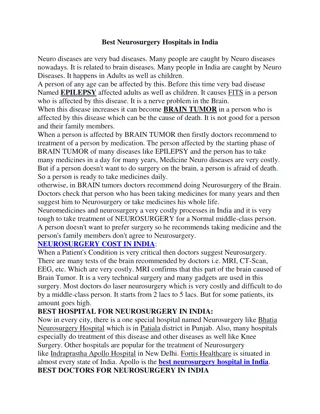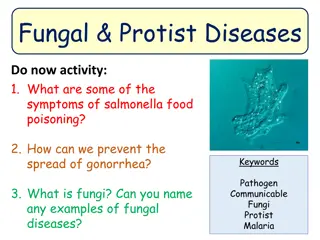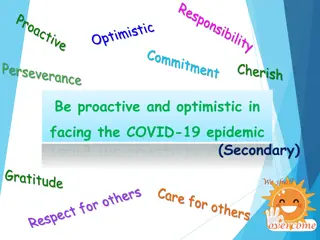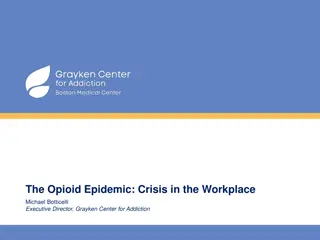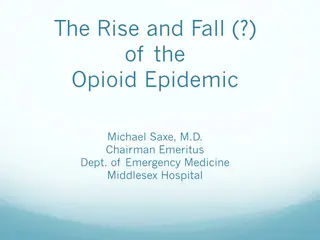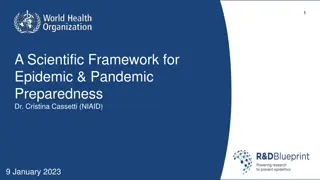
Epidemics of Infectious Diseases
Learn about epidemics of infectious diseases, including causes, transmission factors, and examples such as Middle East Respiratory Syndrome (MERS) and Severe Acute Respiratory Syndrome (SARS). Explore the impact of these diseases on populations and the efforts to combat outbreaks through research and therapies.
Download Presentation

Please find below an Image/Link to download the presentation.
The content on the website is provided AS IS for your information and personal use only. It may not be sold, licensed, or shared on other websites without obtaining consent from the author. If you encounter any issues during the download, it is possible that the publisher has removed the file from their server.
You are allowed to download the files provided on this website for personal or commercial use, subject to the condition that they are used lawfully. All files are the property of their respective owners.
The content on the website is provided AS IS for your information and personal use only. It may not be sold, licensed, or shared on other websites without obtaining consent from the author.
E N D
Presentation Transcript
An epidemic above" and demos "people") is the rapid spread of infectious disease to a large number of people in a given population within a short period of time, usually two weeks or less. epidemic (from Greek epi "upon or
Epidemics of infectious disease are generally caused by several factors including a change in the ecology of the host population (e.g. increased stress or increase in the density of a vector species), a genetic change in the pathogen reservoir or the introduction of an emerging pathogen to a host population (by movement of pathogen or host). Generally, an epidemic occurs when host immunity to either an established pathogen or newly emerging novel pathogen is suddenly reduced below that found in the endemic equilibrium and the transmission threshold is exceeded
Middle East respiratory syndrome, also known as camel flu, is a viral respiratory infection caused by the MERS-coronavirus . However, a number of antiviral medications are currently being studied. Its genomes are phylogenetically classified into two clades, Clades A and B. Early cases of MERS were of Clade A clusters while new cases are genetically different in general . The virus grows readily on Vero cells and LLC-MK2 cells.
Camels A study performed between 2010 and 2013, in which the incidence of MERS was evaluated in 310 dromedary camels, revealed high titers of neutralizing antibodies to MERS-CoV in the blood serum of these animals. Another proposed therapy is inhibition of viral protease Researchers are investigating a number of ways to combat the outbreak of Middle East respiratory syndrome coronavirus, including using interferon, chloroquine, chlorpromazine, loperamide, and lopinavir, and camostat.
Severe acute respiratory syndrome (SARS) was an atypical pneumonia. It started in November 2002 in Guangdong Province, in the city of Foshan, of the People's Republic of China. The disease was caused by the SARS coronavirus (SARS CoV), a new coronavirus. It was also a part-time STD, it can be spread through both sexual and casual contact. SARS was first reported in Asia in February 2003. Over the next few months, the illness spread to more than 24 countries in Asia, North America, South America, and Europe before the SARS global outbreak of 2003 was contained. According to the World Health Organization (WHO), a total of 8098 people worldwide became sick with SARS during the 2003 outbreak; 774 of these died.
After the Chinese government suppressed news of the SARS outbreak, the disease spread rapidly, reaching Hong Kong and Vietnam in late February 2003, and then to other countries via international travellers. The last case in this outbreak occurred in June 2003. There were a total of 8437 known cases of the disease, with 813 deaths (a mortality rate of 9.636%). In May 2005 the disease itself was declared 'eradicated' by the WHO and it became the second disease in mankind to receive this label (the other was smallpox). The New York Times reported that "not a single case of severe acute respiratory syndrome has been reported this year or in late 2004. It is the first winter without a case since the initial outbreak in late 2002. Also, the epidemic strain of SARS that caused at least 813 deaths worldwide by June of 2003 has not been seen outside a laboratory since then."
Ebola virus is a very dangerous virus. It causes a hemorrhagic fever called Ebola virus disease. "Hemorrhagic" means that the victim will bleed a lot, inside and outside their body. Out of every 10 people who get Ebola, on average five to nine die. There are four kinds of Ebola virus that can cause the disease. The virus was first found in Sudan. It is found in Africa, with very few cases in Europe and the United States
The Ebola virus that makes people sick lives in the blood and other liquids and wet things in some kinds of non-human animals without killing them. Scientists think the animals it lives in are mainly some kinds of monkeys or fruit bats. When people touch animals that have the virus, or wet things that came out of those animals, they can get sick. Ebola cannot be caught through the air, or by being near sick people. The virus can only go from liquids into people's bodies. This means Ebola can be caught by touching a sick person's blood, saliva, mucus, semen, diarrhea, vomit, or other fluids that come out of a sick person's body. If a person does not die from the disease, he can still give other people the infection by having sex for nearly another two months after they stop being sick. This is because the virus can still be in the man's semen after a long time.
When people get Ebola the first symptoms look like some other diseases. People get a fever and feel very tired. Their head, stomach, joints, and throat might hurt. Sometimes, people think they have other diseases like malaria or typhoid fever. Later, people get much sicker. They bleed both inside and outside their bodies. They have blood in their diarrhea and vomit. They bleed from their noses, mouths, and genitals/sex organs. They get shock: low blood pressure, fast pulse (heart rate), and low blood circulation to the body. Their organs might stop working. Ebola also causes stiffness throughout the body which makes it hard for sick people to move. Five to nine out of every ten people who get sick with Ebola die.
There is no cure for Ebola, but if people get care quickly from doctors and nurses at a hospital, more of them live. People with Ebola need a lot of fluids to replace fluids lost from diarrhea, vomiting, and bleeding. The most important care is giving them water with a very small amount of salt and sugar in it. This is called oral rehydration. It helps to replace their fluids and blood. It is also important to give medicines in case they get bad blood pressure and blood circulation.
Cholera is an infectious disease. It is caused by a bacterium Vibrio cholerae. This bacteria usually lives in water. Vibrio cholera is more common where fresh water mixes with salt water, like where rivers enter the ocean. It is more common in water with lots of algae.
Cholera is an acute intestinal illness. It causes stomach aches, very watery and continuous diarrhea, and vomiting. The diarrhea and vomiting, in turn, can cause very bad dehydration, leading to death if untreated.
Cholera is contracted by eating foods and/or drinking water contaminated with the bacterium Vibrio cholerae. The most common way people get cholera is by drinking unclean water. People also commonly get cholera from eating fish that is not cooked enough. They can also get it if they eat food or drink that was polluted with the diarrhea from people who have cholera. The most common symptoms of cholera are dehydration and fever.
People with cholera need medical treatment. Most of the treatment for cholera is giving people fluids (water) and electrolytes (salts). For most people with cholera, fluids and electrolytes are given by mouth. This can be done with 80-90% of people. The best way to give this by mouth is WHO-ORS: World Health Organization Oral Rehydration Solution. (Oral means by mouth. Rehydration means to give back fluids and electrolytes to someone who is dehydrated. The solution is a mixture of salts and water.) Some people cannot take enough fluids and electrolytes by mouth. Usually this is because vomiting is so bad. These people must be given treatment intravenously. (Intravenous means into a vein.) Intravenous fluids and electrolytes are given into a person's vein. This is necessary because if people cannot drink enough fluids and electrolytes, they can die quickly.
Bubonic plague is the best-known form of the disease plague, which is caused by the bacterium Yersinia pestis. The name bubonic plague is specific for this form of the disease, which enters through the skin, and travels through the lymphatic system. If the disease is left untreated, it kills about half its victims, in between three and seven days. The bubonic plague was the disease that caused the Black Death, which killed tens of millions of people in Europe, in the Middle Ages. Symptoms of this disease include coughing, fever, and black spots on the skin.
The plague was not just carried by rats as some people assume. The fleas also carried it. It came abroad from Kaffa by the Black Sea. From there the disease started to go new places in 1347. It went to England in 1349. There it killed half of the people in England. 70% of people who got plague died. Pigs are also to blame for the transmission, as the bacteria stayed in their blood system, and when eaten, people caught the plague. This is a reason why so few Jews or Muslims caught the disease.
Human immunodeficiency virus (HIV) is a type of virus called a retrovirus, which infects the human immune system (the system in the body which is in charge of fighting off illness). HIV may cause AIDS (a collection of diseases and symptoms, or problems in the body) by eventually killing the white blood cells, which a healthy body uses to fight off disease.
It is possible that a person can get infected with HIV if any body liquid with the virus gets into their body. The body liquids that carry HIV are blood, semen, liquid from the vagina, and breast milk. The liquids can go into the body through injured skin. The liquids can also enter through the mouth, eyes, nose, vagina, anus, or penis. However, though HIV might enter the body through any of these places, when people get HIV by having sex, the virus usually enters the body through the vagina or anus. There are some common ways to get HIV: A person with HIV can give a sexual partner the virus if they have unprotected sex. That means having sexual intercourse without a condom. A person can get HIV if he or she uses the same needle as a person with HIV to inject drugs or get a tattoo. A person may get HIV if he or she is stuck by a needle that was used on a patient with HIV.
Babies can get the virus from their mothers when they are born or when they are breastfeeding. A baby may be protected from getting HIV this way if their mother takes certain medications while she is pregnant. Blood transfusions using infected blood products was a common cause of HIV. The blood had been taken from people with HIV infections. Now, in the developed world screening of blood products for HIV has mostly stopped this happening. However, people may still get HIV from blood transfusions in less- developed countries if blood is not screened carefully. A person cannot get infected with HIV from non-sexual touching, like a hug or handshake, or touching someone else's saliva. A person cannot get HIV from an insect bite, a cough, or a sneeze.[1] People also cannot get HIV from touching light switches, using toilets, or drinking from the same glass as a person with HIV.
Influenza, better known as the flu and sometimes called the grippe, is a common childhood illness, but is not as common among adults. It is not limited to humans, most mammals and many birds can also catch influenza. It is caused by several different viruses (see: RNA virus), which is why people can have the flu more than once.. The name influenza comes from Italian: influenza, meaning "influence".
Human Influenza can pass from one person to another very easily. It is most commonly spread by the microscopic droplets of mucus and fluid that are sent into the air when the sick person coughs or sneezes. Symptoms include cough, sore throat, muscle aches and pains, fever, headache, and rarely vomiting and diarrhea. Influenza can also lead to other diseases, such as pneumonia. This makes it especially dangerous to young children and elderly people. Although there is no cure for influenza, Antiviral drugs can be used to treat the illness so it is not as severe and does not last as long. The influenza season runs from late fall to spring because most people catch it in the winter months. When there are more cases of influenza than expected, it will sometimes be called an epidemic. When there are a large number of cases of the same type of influenza all over the world, it is often called a pandemic.
Swine Flu (March/April 2009) This new flu virus got its name because it contains genetic parts that are commonly found in flu viruses that infect pigs. It is not spread by pigs or by eating pork - this is a new human virus being spread by humans. Although information is still coming out about Swine Flu, so far it does not seem to be as severe as Bird Flu or the flu that caused the Influenza Pandemic of 1918 (also known as Spanish Flu), but it is much too early to predict whether it will cause the next flu pandemic.



